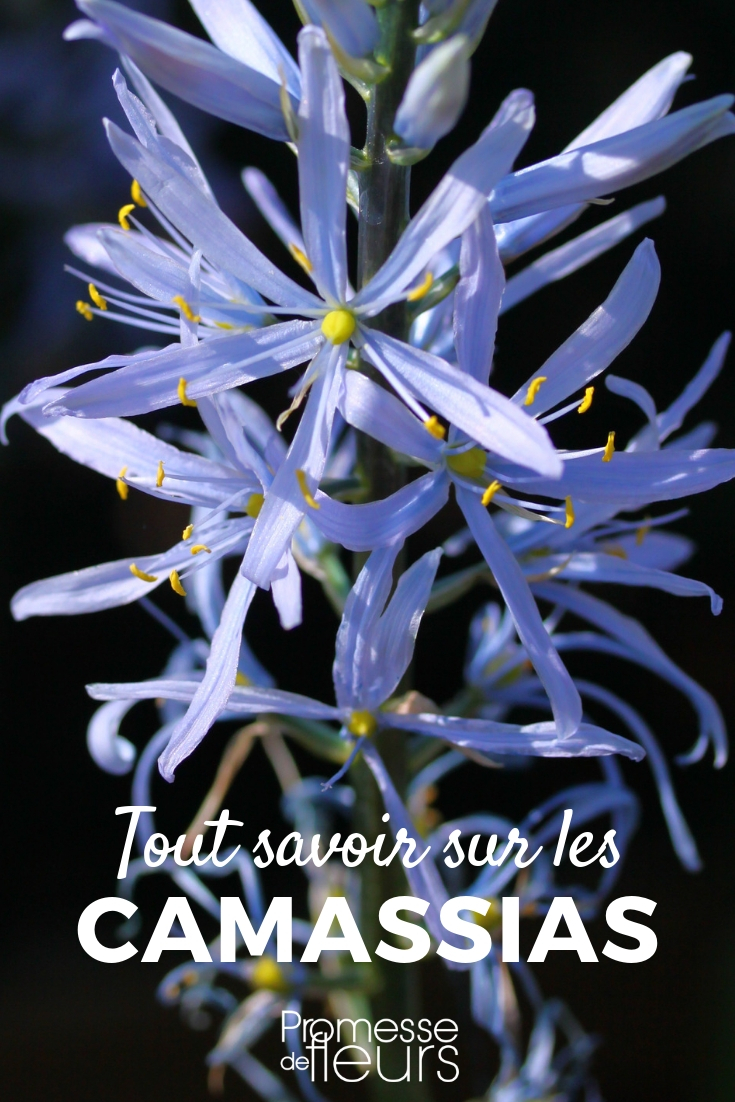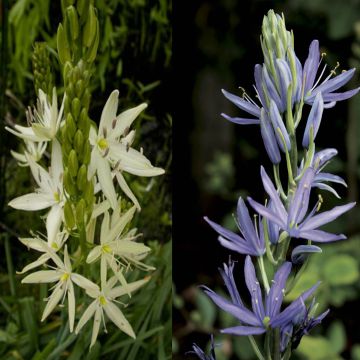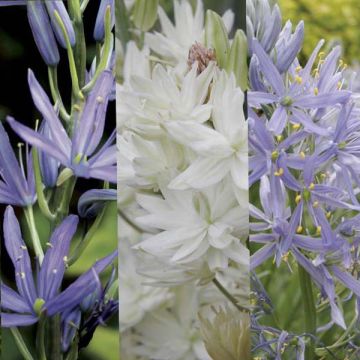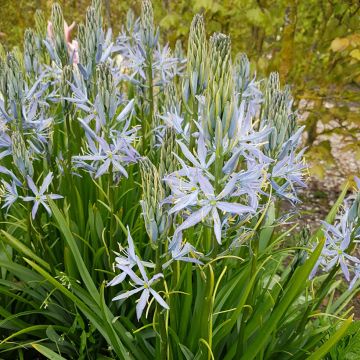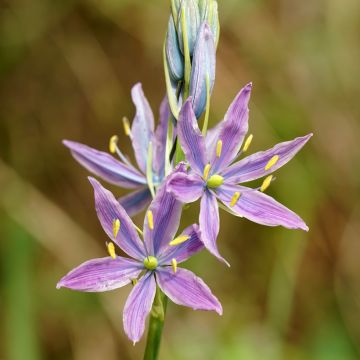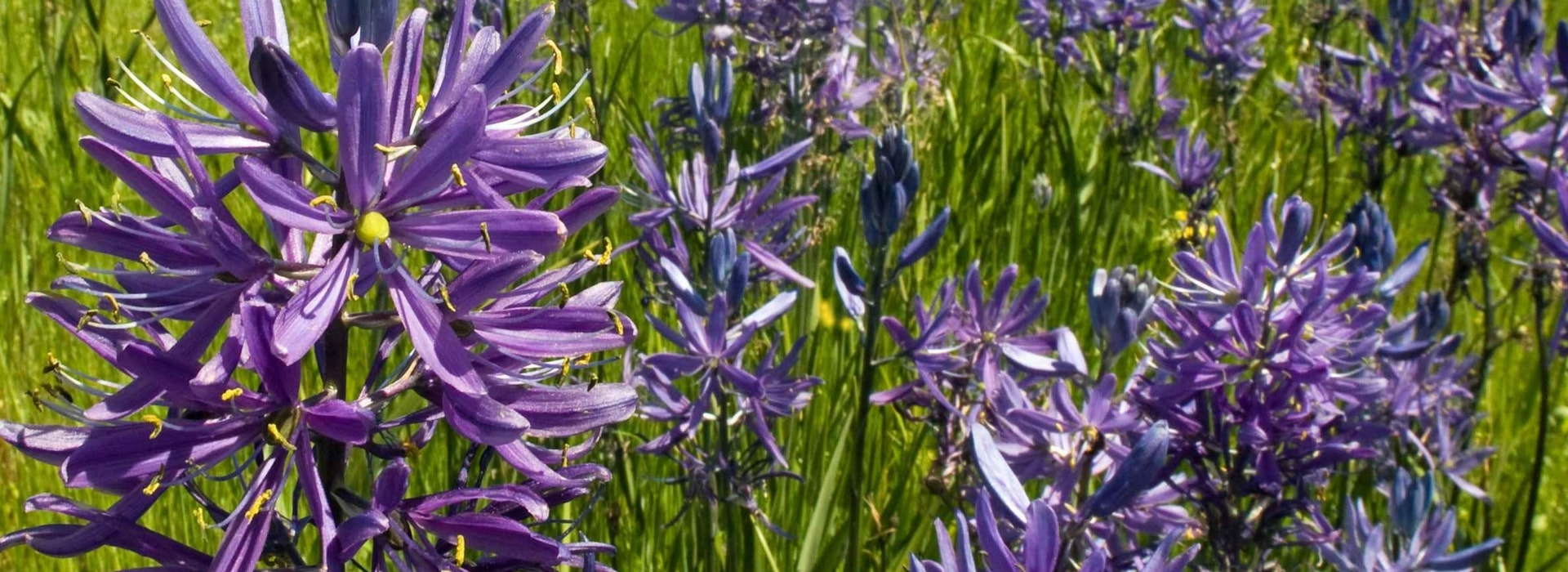
Camassia: planting, caring for and associating in the garden
Contents
Camassia, in a nutshell
- Camassia is a hardy bulbous perennial that flowers in spring and naturalises easily. It is THE stunning tall flowering plant for partial shade and heavy soil.
- It produces large spikes of numerous star-shaped flowers, either blue or white, on tall, sturdy stems.
- Camassia is easy to grow: very hardy and low-maintenance, it thrives in both partial shade and non-scorching sun. It is suitable for all types of soil, even clay.
- It is a beautiful bulbous plant, still relatively unknown, that easily finds its place in the garden: plant it in masses, in a wildflower meadow style, in mixed borders with perennials or other spring bulbs, and even in pots or at the edge of a pond with lush hostas… It is also stunning in bouquets.
- Sometimes referred to as “Quamash”, “Camassia” or “Indian Hyacinth”, it is native to the wet prairies of North America.
A word from our Expert
The Camassia is a bulbous perennial that displays, each year in spring, spectacular blue or white flowers perched atop tall stems. Its inflorescences are composed of a multitude of charming star-shaped flowers gathered in a spike.
The Camassia is a very hardy plant. It thrives ideally in cool, moist soil. Unfussy, it adapts to all types of soil, including clayey ground. In terms of exposure, it particularly enjoys partial shade, but will also do very well in full sun, provided it is not scorching.
Truly indestructible, the Camassia is the quintessential flowering meadow plant, as it has the advantage of naturalising. In just a few years, it can colonise beautiful expanses, appearing very natural, without any intervention from the gardener.
The Camassia is one of our favourite perennial plants. Long overlooked, we are delighted to see it finally emerging from obscurity. Valued for its robustness and beautiful stature, you will now frequently encounter it in the parks and public gardens of our cities.
Botany
Botanical data
- Latin name Camassia
- Family Asparagaceae (previously classified in the Liliaceae and then Hyacinthaceae)
- Common name Indian Hyacinth, Camassia, Quamash or Camash
- Flowering Flowering from May to June, numerous star-shaped flowers 5 to 7 cm in diameter, gathered in a spike.
- Height from 50 cm to 1.20 m (depending on the varieties) - Spread
- Exposure partial shade, non-burning sun
- Soil type all (even clayey), rich, fresh to moist, but well-drained
- Hardiness below -20 °C
The Camassia is native to the plains, most often wet, of the western United States, from Oregon to California. Six species are recorded there: Camassia angusta, Camassia cusickii, Camassia howellii, Camassia leichtlinii, Camassia quamash, Camassia scilloides.
It is a perennial bulbous plant that establishes itself and then flowers for many years. It forms a clump of bright green leaves, 20 to 60 cm long. They are lanceolate and upright. Deciduous, the foliage disappears during the summer and then regrows in spring.
The Camassia generally flowers in May – June. A long sturdy stem emerges from its foliage. And although it can reach up to 1.3 meters high, its robustness allows it to stand without support. At its top, a spectacular flower spike develops, 10 to 30 cm long and composed of numerous star-shaped flowers (5 to 7 cm in diameter). These have the particularity of appearing gradually, from the bottom to the top, over a period of about fifteen days.
These flowers bloom in a lovely palette of colours ranging from ivory white to violet, including azure blue and mauve. Long and beautiful yellow or white stamens stand out from each of its star-shaped flowers, offering a harmonious contrast. The Camassia has excellent vase life and allows for the creation of magnificent bouquets. Although unscented, this melliferous plant will attract pollinating insects, bees, butterflies, essential for the pollination of flowering plants, fruit trees, or vegetables…

Camassia sacajewa – Camassia leichtlinii caerulea – Camassia leichtinii semiplena
Over the course of botanical classification evolution, the Camassia has been associated with different plant families. Initially, among the Liliaceae: it was thus considered a cousin of the tulip, the quintessential bulb plant. Then attributed to the Hyacinthaceae, of which hyacinths are the most obvious representatives, probably due to their many commonalities: colour, foliage, bulb… Botanists now classify plants based on their DNA, and the Camassia has joined the Asparagaceae family, like asparagus. This is not so surprising, as the Camassia is considered a vegetable plant!
Indeed, the bulb can be consumed, raw, boiled, or dried. Once, it was highly valued by the Plains Indians. Moreover, the word Camassia comes from “Kamash,” which means sweet in Native American. According to sources, the taste is similar to either sweet potato, chestnut, or even cooked pear. To clarify, you just have to test the taste qualities of the Indian Hyacinth yourself. However, be aware that it has the same digestive drawbacks as Jerusalem artichoke. Caution: the rest of the plant is toxic!
Our varieties of Camassia
Main varieties:
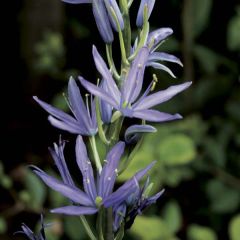
Camassia leichtlinii subsp. suksdorfii Caerulea
- Flowering time May, June
- Height at maturity 80 cm
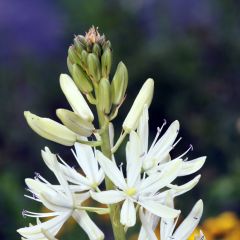
Camassia leichtlinii Alba
- Flowering time June, July
- Height at maturity 90 cm
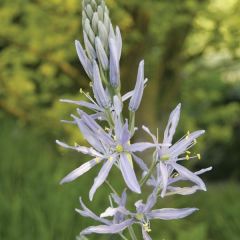
Camassia cusickii
- Flowering time June, July
- Height at maturity 80 cm
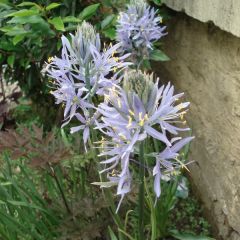
Camassia cusickii Zwanenburg
- Flowering time June, July
- Height at maturity 70 cm
Our favourites:
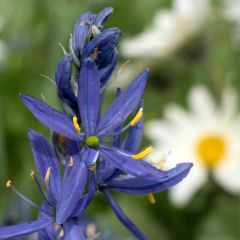
Camassia quamash
- Flowering time June, July
- Height at maturity 60 cm
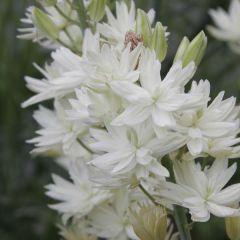
Camassia leichtlinii Semiplena
- Flowering time June, July
- Height at maturity 90 cm
Discover other Camassia
View all →Available in 0 sizes
Available in 0 sizes
Available in 2 sizes
Available in 3 sizes
Available in 2 sizes
Available in 1 sizes
Available in 1 sizes
Available in 1 sizes
Available in 2 sizes
Available in 1 sizes
Young plantation
When to Plant?
Autumn is the ideal time to plant your Camassia bulbs. Like Tulips and all other bulbs, they will flower the following spring.
If you are a bit late, know that it is still possible to extend the planting schedule and plant later (until December, as long as the soil is not frozen), without any problem.
How to Plant?
To plant your Camassias, simply make a hole 10 to 15 cm deep, loosen the bottom well, and place the bulb in it, point facing up. Then cover it back with soil and firm it down. There you go, it’s done!
The bulbs will remain in the ground all winter without any problem; they are very cold-resistant, down to -20 °C, even in wet soil.
Where to Plant?
We advise you to take some time to choose the ideal spot in the garden, where you won’t disturb them again, as they hate that!
Whether in full sun or partial shade, your Camassias will thrive in rich, cool soil and will form generous clumps for many years to come.
- In a flowerbed: In combination with spring bulbs, tulips, ornamental garlic, fritillaries… the wide choice will satisfy everyone’s tastes and preferences. For a better effect, plant them in groups of 4 or 5 bulbs, taking care to space them 20 cm apart. Also, remember to mark their location: their foliage is deciduous and disappears in summer, making it easy to forget the exact spot where they are planted. It would be a shame to damage them with an unfortunate spade strike!
- In a meadow: To achieve a natural look, the simplest technique is to take a handful of bulbs and toss them over your shoulder to avoid an overly artificial alignment. You will plant them where chance has made them fall, at about 6 bulbs per m². As they naturalise, over the years, the Camassias will fill the space to form a wonderful carpet in spring… To prolong this effect, feel free to combine several varieties like Camassia leichtlinii Caerulea, which flowers in April – May when the grass is still short, with Camassia Quamash, which flowers in May – June and will accompany the buttercups. At the end of summer, you can mow your meadow, as the foliage, essential for replenishing the bulb’s nutrient reserves, will have already disappeared.
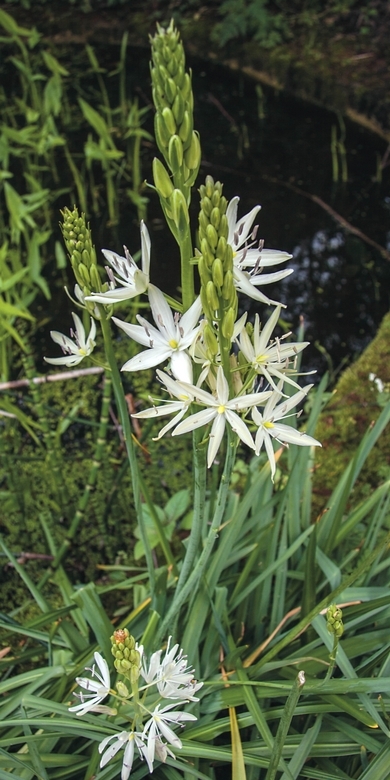
- In a particularly wet spot in your garden, by a pond, along a stream, or near a spring, Camassia will pair wonderfully with bank plants like Marsh Marigold, Hostas…
- On a terrace or balcony: Camassias grow very well in pots. To vary and stagger the flowering throughout spring, choose a large container (50 cm in diameter) and use the lasagna planting technique. This involves planting bulbs in successive layers, each separated by 10 cm of potting soil: first, fill the bottom of the pot with gravel or clay balls, about 2 cm thick, to ensure drainage. Then place, in order from bottom to top, daffodils, Camassias, tulips, hyacinths, and finally muscari or crocuses, followed by a final layer of potting soil.
Maintenance
Resilient, durable, and low-maintenance, Camassias are definitely easy to live with! They are unaffected by disease or parasitic threats. Their bulbs are generally overlooked by rodents, who find them too tough for their teeth. As for gastropods, there’s little to worry about: slugs and snails hardly appreciate their foliage. Excellent news, right?
Maintenance is minimal: in borders, you can remove the faded flowers, which will prevent seed formation that tends to exhaust the bulbs. But do not cut the foliage, as it is essential for replenishing nutrient reserves. Wait until summer, when it is completely dry, as this indicates that the plant is in a resting period.
Camassia bulbs can, of course, stay in the ground all winter; they are very hardy, resilient, and not afraid of frost, even in wet soil.
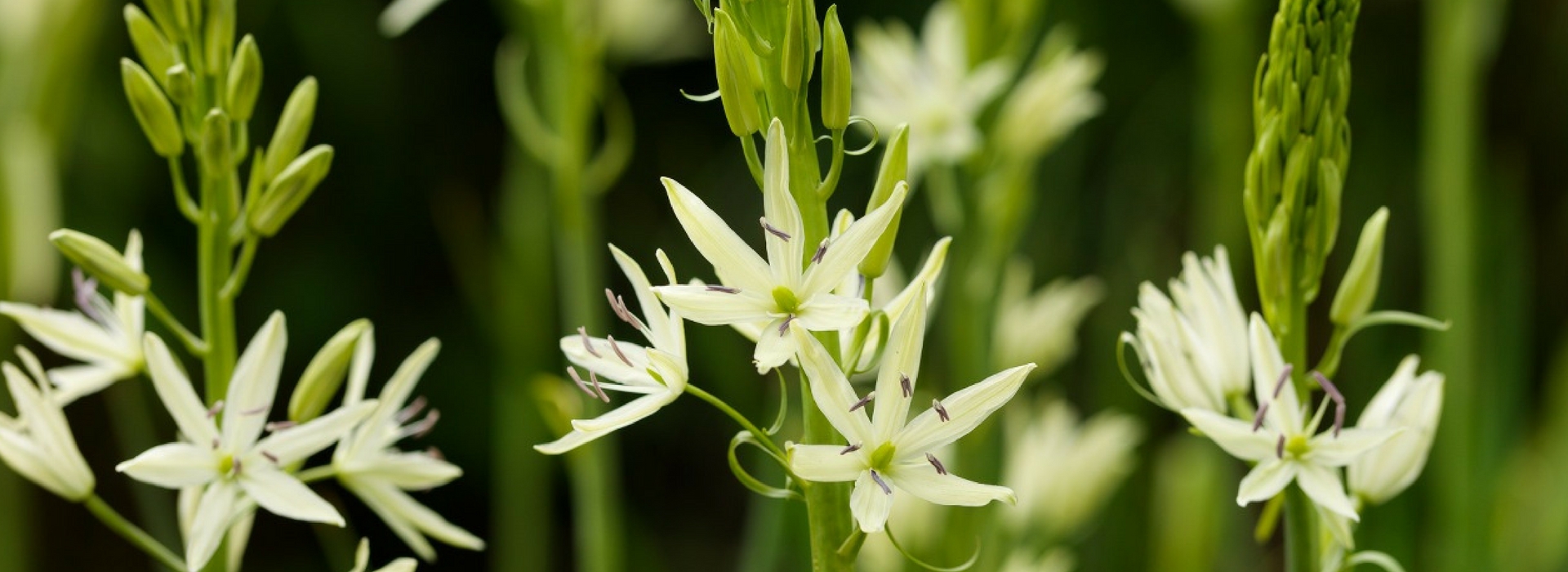 Camassia leichtlinii Alba</caption]
Camassia leichtlinii Alba</caption]
Multiplication
There are two methods to propagate Camassia: sowing and division.
Sowing
Sowing Camassia is possible, but it is a bit lengthy and complicated. Indeed, the seed requires a cold stratification period to break dormancy, which is essential for germination. This dormancy is a resting period that allows the seed to wait for spring without exhausting itself. During winter, the cold gradually weakens the seed coat (this is stratification), and with the arrival of the first warm days, germination will become possible. You can artificially recreate this cold period by storing your patiently harvested seeds in the refrigerator.
You will then sow them in spring, and if all goes well, seedlings will develop. You will just need to wait for 4 to 5 years before obtaining the first flowering!
In the garden, spontaneous sowing sometimes occurs: don’t complicate your life, just let nature take its course…
Division
Division is the fastest, easiest, and most effective method for propagating Camassia. Dividing the clumps is done in summer, before the foliage disappears, as it is easier to spot them then. Choose well-developed subjects that are at least three years old.
Indeed, like tulips or daffodils, each Camassia bulb produces bulblets, which will grow into new bulbs. They will develop leaves in turn and then flower after a few years.
You can also simply divide the clump in two or carefully separate each bulb and replant them one by one. Installing new bulbs is undoubtedly the quickest and most effective method. It also has the advantage of being an opportunity to introduce new varieties into the garden.
Association
Camassias combine very easily. A clash of taste is impossible: white or blue, varying in intensity, blend effortlessly with red, yellow, or even orange for a very vibrant effect!
The only factor you need to consider is the height of the flower spike, which can range from 60 cm to 1.3 metres depending on the variety.
Here are some suggestions and ideas for combinations:
In a border, plant your Camassias alongside all the other spring bulbs: Tulips, Ornamental Alliums, Fritillaries, Daffodils… The possibilities are endless and can evolve each year, according to your desires.
Place your Camassias in a perennial bed: Hosta, Geranium, Fern, Heuchera have the advantage of hiding the foliage of the Camassias, which, like that of Daffodils, is not particularly interesting once flowering is over.
Pair your Camassias with Astrances: these two plants enjoy the same environment (rich, cool soil, in partial shade) or plant them at the base of a rose bush, alongside delphiniums and campanulas that will take over, just like in the wonderful English cottage gardens.
Plant your Camassias at the foot of a purple-leaved bush, a Japanese Maple or a Cotinus; they will create a foreground of great ornamental value.
Along the banks of a stream, or within a wet area of your garden, try them alongside plants that appreciate the same growing conditions: Hostas, Candelabra Primrose, Fern…

Hosta ‘Neptune’ – Camassia leichtlinii – Droypteris filix mas
For a striking graphic effect, place a pot of Camassias on your terrace, in front of a lovely wall… This way, you can fully appreciate every detail of the flower.
Last but not least, plant your Camassias to create a stunning flower meadow: this is their natural habitat, their flowers will delight you in spring, and they will naturalise over time.
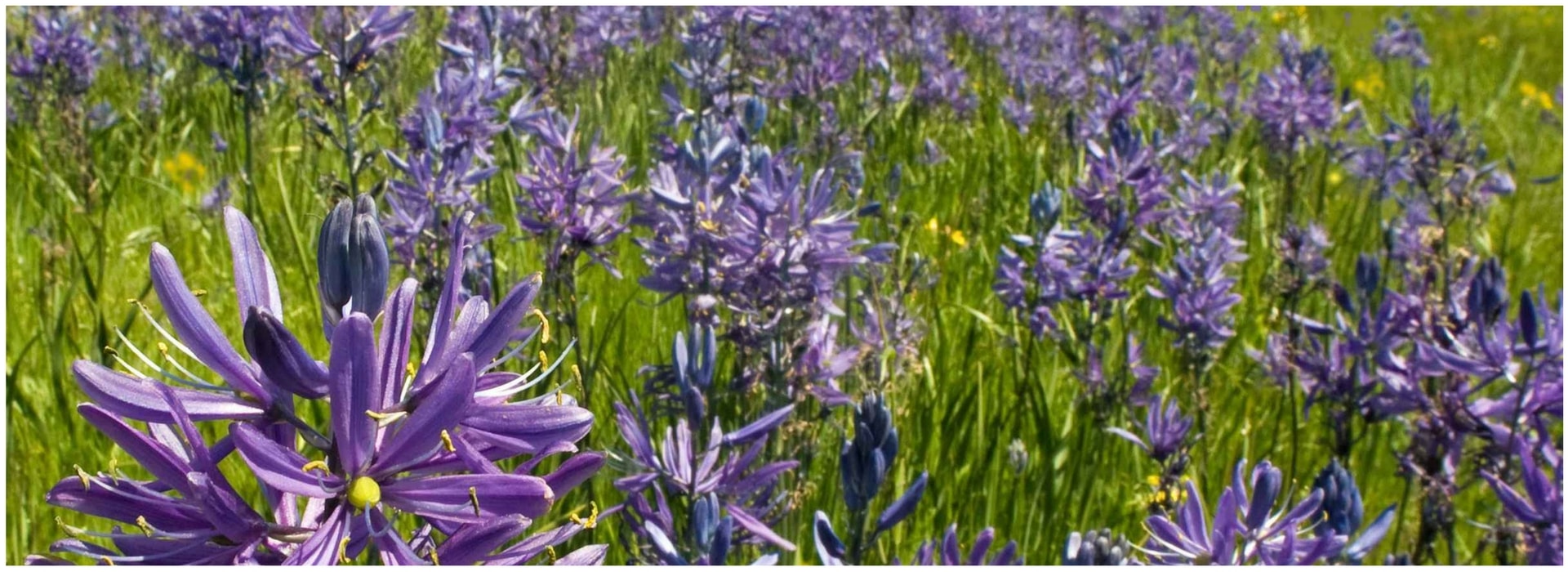
Camassia leichtlinii in meadow
Finally, know that Camassias are kings in English gardens. In 2015, at the Chelsea Flower Show, Chris Beardshaw particularly showcased them. Let yourself be guided; here is the plan for this superb creation and the list of associated plants (in Latin).
Useful resources
Discover our beautiful collection of Camassias!
- Subscribe!
- Contents
